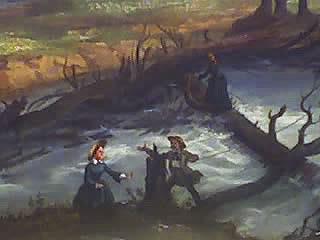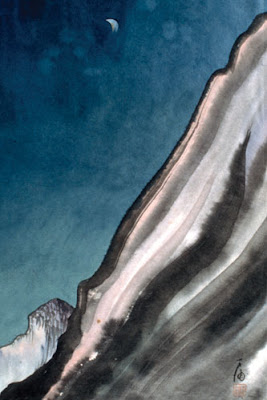I made the mistake of reading and believing in the National Weather Service’s reports for southern California last night. Rain was already falling in Los Angeles late Saturday night, and the reports said it would continue into Sunday afternoon, with 1-3 inches of snow in the upper elevations of the San Gabriels.
So I unset my alarm and prepared to sleep in on Sunday for a change. When I did wake up at 9:30, it was to crystal clear blue skies.
It only rains here maybe two weeks out of the year. You think they’d be able to get those days correct.
But oh well.
Because I’d feel bad if I didn’t do something at least tangentially related to the outdoors on my Sunday, I made a trip up to Griffith Park to the Autry National Center. The museum itself is a pretty comprehensive interpretive history of the American West – it’s early times, colonization, and Americanization. But of particular interest to hikers is their current exhibition, “Yosemite: Art of An American Icon.”
It’s a two-part, semi-staggered exhibition of works. The first consists of paintings, drawings, photographs, and artifacts from 1855-1969, the second from 1969 to the present. The opening gallery begins with early landscape sketches of the Valley, relatively undisturbed and pristine. Soon thereafter, the gallery is filled with promotional images intended to draw settlers and prospectors to exploit the same idyllic wilderness.
It’s also got a few paintings of early Victorian hikers. Crossing a raging river on a log while wearing a giant dress and corset? Yeah, I think we have it easier.
The first galley also has an excellent collection of early Muybridge and Ansel Adams prints, as well as some really interesting paintings. Of particular note were the works by Chiura Obata (comprehensive but infuriatingly slow Flash site here, better image gallery here), a Japanese immigrant who captured the American landscape in a traditional Japanese style:
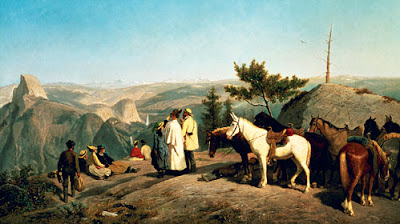 Yosemite Valley from Glacier Point – William Hahn
Yosemite Valley from Glacier Point – William Hahn
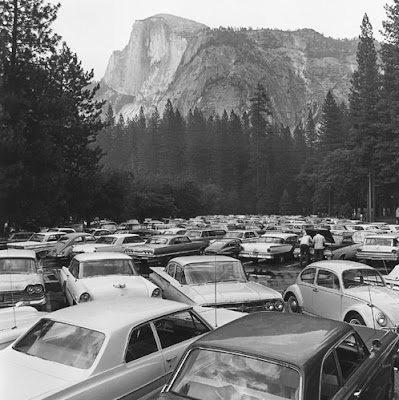 And on the flipside, there’s the iconic “Woman with Scarf at Inspiration Point” by Roger Mitnick. At first, it appears to be another comment on the oversaturation of commerce in the Yosemite Valley. But there’s something about that unnamed woman staring off into the distance …
And on the flipside, there’s the iconic “Woman with Scarf at Inspiration Point” by Roger Mitnick. At first, it appears to be another comment on the oversaturation of commerce in the Yosemite Valley. But there’s something about that unnamed woman staring off into the distance …
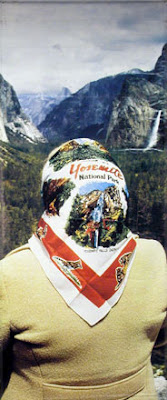 I can remember when I first rounded a bend in the road and caught a glimpse of the Valley in full. You see it, and you’re speechless. Pictures don’t prepare you, and all you can do is pull over to the side of the road and silently take it all in. Personally, while I’m inclined to reduce accessibility of cars into National Parks, I don’t know if I could sleep soundly knowing that someone – anyone – was denied their chance to see something so majestic.
I can remember when I first rounded a bend in the road and caught a glimpse of the Valley in full. You see it, and you’re speechless. Pictures don’t prepare you, and all you can do is pull over to the side of the road and silently take it all in. Personally, while I’m inclined to reduce accessibility of cars into National Parks, I don’t know if I could sleep soundly knowing that someone – anyone – was denied their chance to see something so majestic.
It’s a balance, I guess.
– Yosemite: Art of an American Icon runs at the Autry National Center before traveling to Reno and Indianapolis.
– Gallery One, 1855-1969 is open through January 21st. Gallery Two, 1969-Today is open through April 22nd.
– Admission is nine dollars for the museum, six and change if you’ve got your Triple A card on you. And who in L.A. doesn’t have Triple A?
– Go to freshen up your on-trail snapshot skills. And for map junkies, the permanent exhibit has some great early maps of the frontier explorations.
Tags: Yosemite National Park

